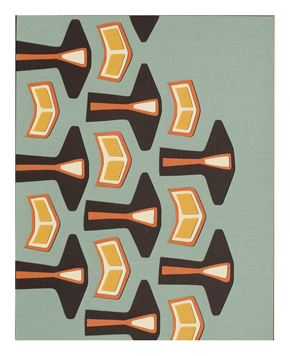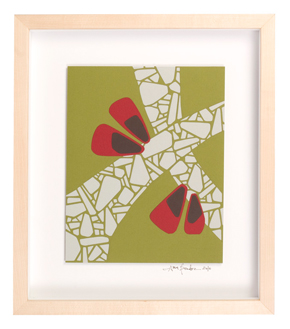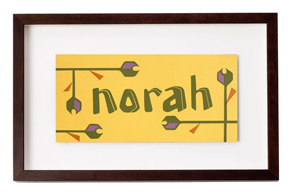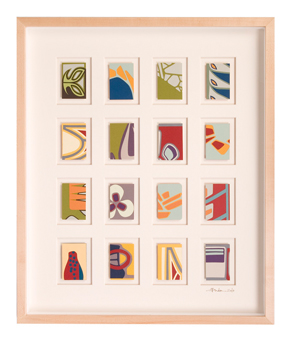Anna Bondoc
I love the dualism of Anna Bondoc’s work. This L.A. based artist works in one of the most seemingly simple forms around–paper. But what she does with an X-acto knife creating and cutting these layers is like nothing else. Working and whittling down pieces ever so intricately, using shapes and designs that appear like a modern twist to an ancient medium dating back to origami.
I had the chance for a Skype interview with Anna and her business partner Vanessa Peter in which we chat about perfectionism, patterns, and parenthood.
dp There’s something so simple about working with paper, yet, your work is so intricate, how do you balance that?
ab The simplicity is true it really comes from my background as a printmaker. I like the idea of layers of color, very graphic, and sharply designed shapes. After I had my daughter it was one activity I could do in small bursts and when you’re working with paper there’s immediate color. There’s no weight, no machinery, just paper and an X-acto knife.
That sort of intricacy comes because I enjoy the repetition of it and the actual cutting and as I work with the layers the layers then turn into shapes and all nest with each other and mimic the first shape that I cut.
Similar to when you’re a child making snowflakes the magic of cutting out a shape and having the paper not fall apart and holding it up to the light, seeing that you created a positive space out of a negative space. That forces me to slow down; I’m taking the time to cut and thinking deeply about how colors interact. I’m not rushing through it on a computer, which is very fast. It’s much more deliberate than on a computer.
dp Your work to me seems very influenced by Japanese forms, and even origami, where does that come from?
ab I don’t really know. I do know that when I open up and choose my own art books there was always a negative space and industrial design. Hours and hours spent looking at books. I just kept gravitating towards Japanese design. Lots of open space, but there’s a sense of restraint.
dp How does living in Los Angles affect and influence your work? Because I think L.A. in general would be a complete contradiction to your tight, clean style.
ab L.A. doesn’t necessarily affect me, but my inner goal. I love traveling because it brings layers of history. The California lifestyle has allowed me to bring out levels of concern … in L.A. you have hiking everyday and swimming and in NY (where I used to live) you have twitter everyday.
dp Which is interesting because I think in this conversation and the grid and sort of pattern of New York is would be more you and it’s interesting to me that L.A. and the nature that it is sort of is the balance for you.
ab I feel like NY left sort of an intellectual footprint on me. But, with a child it’s a little too much.
dp How does being a mother influence your work? Or how does it not?
ab This pushed me into art because when I had minutes of free time I worked. Before I was sort of cerebral and thought it through in ways that I don’t now. Now, it’s put up or shut up. Are you going to create or are you not?
And made me think why is a child’s name such a big deal? Now I understand that connection. My work is now a reflection of giving myself one tiny goal and giving myself a space to work.
dp How do you know when a piece is finished? Is it an aesthetic feel or emotional one? With your pieces because there are so many layers, when do you walk away?
ab It’s kind of when I run out of space to cut and those windows are full. And then there is always that question of–do I feel balanced? Does the piece feel top heavy? Bottom heavy? Does the negative shape take too much space? I’m not a gardener, but I imagine that must be how a gardener must feel. Is this space too intricate? My eye now will notice a slight imbalance.
dp You work really resonates with me because there seems to be an exactness and preciseness that I can appreciate. Does that piece of your personality only come out through your work?
ab I was raised in an Asian household and was a chef for a little while and my leaning was towards pastry, which is mathematical. I enjoy the chemistry and exactness of that, that kind of completeness is why I enjoy working with a knife. I want that clean boundary so I can see exactly how a shape interacts with the color. I see it in my parenting. My daughter is on a very strict schedule. I get satisfaction in making right.
dp What’s next for you?
ab The big thing is our launch and after we launch with our product–I’m not just creating layered pieces on paper, it’s on a knitted product, a rug, and beyond. When people see my work they generally say this would look so great on such and such. I would also love to see it on wallpaper. I don’t picture someone wearing it because it’s so big, but it would be great in a fabric.
We love being on the learning curve. Cut paper is fun, but part of the learning curve is what kind of yarns are out there to make a children’s sock and what kind of manufacturers. And how you translate a flat pattern into a fiber. We have fun contemplating what we must learn.
dp Which is interesting because I think most people don’t want that side to them to be exposed. They do what they know. Interesting that you’re not only willing to step outside of that box, but explore around a bit.
ab It’s fun. And I think I come from an entrepreneurial family. We’re used to the layers and when you look at things you can use it’s endless. Can we work with leather and layer it? Rugs? It’s so exciting.
dp How can my readers get one of your fabulous pieces?
ab Order online through the website–annabondoc.com












